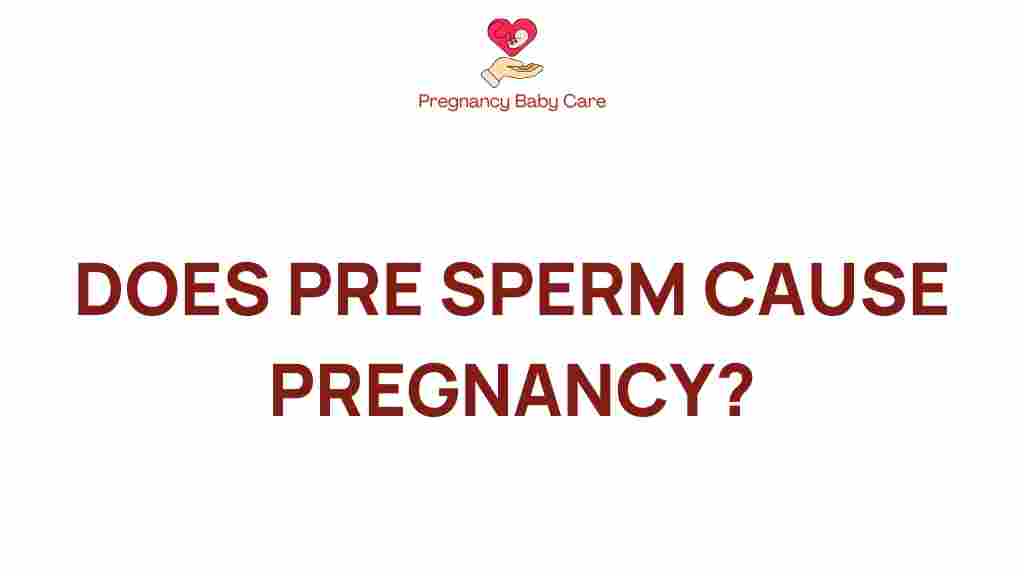Unraveling the Mystery: Does Pre-Sperm Really Cause Pregnancy?
When it comes to sexual health and reproduction, there are many myths and misconceptions that can create confusion. One of the most debated topics is whether pre-sperm can lead to pregnancy. This article aims to unravel the mystery surrounding pre-sperm, its role in conception, and the risks involved. Understanding the facts can empower individuals with knowledge about their fertility and sexual health.
What is Pre-Sperm?
Pre-sperm, also known as pre-ejaculatory fluid, is a clear fluid released by the penis during sexual arousal. This fluid is produced by the Cowper’s glands (bulbourethral glands) and serves several purposes:
- It acts as a lubricant during intercourse.
- It helps neutralize acidity in the urethra, making it more hospitable for sperm.
- It may help to flush out any residual urine that could harm sperm.
Many people wonder if this fluid contains sperm and whether it can lead to pregnancy. The answer is nuanced and requires a closer look at fertility and reproduction.
The Role of Sperm in Conception
In order for pregnancy to occur, a sperm cell must fertilize an egg. Sperm are produced in the male reproductive system and are typically released during ejaculation. However, the presence of sperm in pre-sperm is where the mystery lies.
Can Pre-Sperm Cause Pregnancy?
Research has shown that pre-sperm can occasionally contain live sperm, although the quantity is usually low. The chances of getting pregnant from pre-sperm depend on several factors:
- Timing: If ovulation is approaching, the likelihood of sperm in pre-sperm leading to conception increases.
- Fertility health: The fertility status of both partners plays a crucial role.
- Presence of sperm: If there are residual sperm in the urethra from a previous ejaculation, it can mix with pre-sperm.
Understanding the Risks
While the risk of pregnancy from pre-sperm is lower compared to ejaculate, it is not zero. Here are some considerations regarding the risk of pregnancy from pre-sperm:
- Myths vs. Reality: Many people believe that pre-sperm is completely sperm-free, which is a myth. Although the concentration of sperm is lower, there is still a possibility.
- Withdrawal Method: Relying solely on the withdrawal method (pulling out) can be risky, as pre-sperm may be released before ejaculation.
- Fertility Awareness: Understanding your own cycle can help mitigate risks, but it is not foolproof.
Myths About Pre-Sperm and Pregnancy
Several myths circulate regarding pre-sperm that can mislead individuals. Here are some common misconceptions:
- Myth 1: “Pre-sperm cannot cause pregnancy at all.”
Reality: While less likely, there is a chance of pregnancy if pre-sperm contains viable sperm. - Myth 2: “All pre-sperm is free of sperm.”
Reality: Pre-sperm can contain sperm, especially if there was a recent ejaculation. - Myth 3: “Using a condom will not help with pre-sperm.”
Reality: Condoms are effective in preventing both pre-sperm and ejaculate from causing pregnancy.
How to Reduce the Risk of Pregnancy from Pre-Sperm
If you’re concerned about the possibility of pregnancy from pre-sperm, there are several methods to reduce the risk:
- Use Protection: Condoms are highly effective at preventing pregnancy and sexually transmitted infections (STIs).
- Consider Hormonal Birth Control: Birth control pills, patches, or IUDs can provide additional protection against pregnancy.
- Track Your Cycle: Understanding ovulation can help in timing intercourse to avoid higher fertility days.
- Communicate: Discuss birth control options and concerns with your partner to make informed decisions.
Step-by-Step: Understanding Fertility and Conception
To better understand how pre-sperm fits into the larger picture of conception and fertility, consider the following steps:
Step 1: Understanding Ovulation
Ovulation is the process where an ovary releases an egg, making it available for fertilization. This typically occurs around the middle of the menstrual cycle for women.
Step 2: Timing Intercourse
Having intercourse during the fertile window (a few days before and the day of ovulation) increases the chances of conception. If pre-sperm is released during this time, the risk of pregnancy increases.
Step 3: Sperm Viability
Sperm can survive in a woman’s reproductive tract for up to five days. This means that if pre-sperm contains live sperm, it can potentially lead to pregnancy even if intercourse occurs days before ovulation.
Step 4: Using Protection
Utilizing condoms and other forms of birth control can significantly reduce the risk of unintended pregnancy.
Troubleshooting Tips for Sexual Health
Maintaining sexual health and understanding the risks associated with pre-sperm is crucial. Here are some troubleshooting tips:
- Regular Check-Ups: Schedule regular visits with a healthcare provider for sexual health screenings and advice.
- Educate Yourself: Stay informed about reproductive health to make empowered decisions regarding fertility and contraception.
- Open Communication: Discuss any concerns or questions about sexual health with your partner.
- Consider Professional Guidance: If you’re trying to conceive or avoid pregnancy, consider consulting a fertility specialist or a sexual health expert.
Conclusion
In conclusion, while pre-sperm may carry a lower risk of causing pregnancy compared to ejaculation, it is still a significant factor in the conversation about fertility and reproduction. Understanding the role of pre-sperm, the myths surrounding it, and the risks involved can help individuals make informed choices about their sexual health. By practicing safe sex and being educated about fertility, couples can navigate their reproductive journeys with greater confidence.
For more information on sexual health and fertility, consider visiting this resource for comprehensive guides and tips.
Stay informed, stay safe, and make the best decisions for your reproductive health!
This article is in the category Pregnancy and created by PregnancyBabyCare Team
